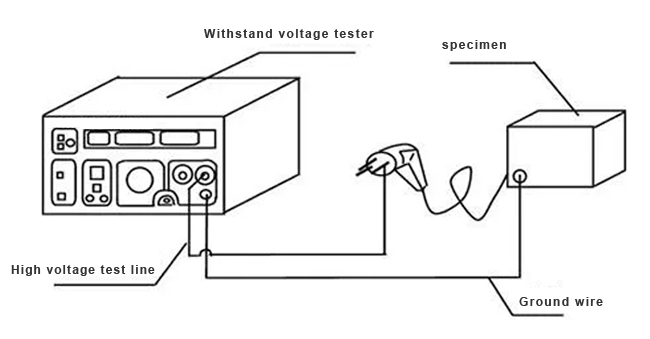What exactly is the principle of withstand voltage testing?
The basic theory for withstand voltage test is to make a product exposed under extremely hostile environment, if the product can still regular works, that means the product can certainly keep working in normal condition. Different product has different specification, when do the withstand voltage test, a voltage higher than working voltage would be on the specimen and keep for a certain time, if the leakage current of the parts is in the normal range during the time, that means the parts is very safe when operate under the normal voltage, and reasonable design and good insulating material can well protect the user.

The purpose for withstand voltage test is to protect the user from electric shock, and keep the user and contactor safety. To do the high voltage test can test the following items:
-
Insulating strength of insulating material
-
To check if any gap or pinhole on insulator
-
To check if the safe distance is enough or not between the parts
-
To check if the contactor is damage or not caused by extrusion and dropping.
For general equipment, withstand voltage test is to test the leakage current between fire wire and enclosure. Normally, the test voltage should be 2* working voltage+1000V, for some special products, the test voltage will be higher. For example, the working voltage is from 100V to 240V, the test voltage may be 1000V to 4000V or higher. Generally speaking, the “double insulation” designed products will require higher test voltage.
Generally, AC withstand voltage test (ACW test) is easier accepted than DC withstand voltage test (DCW test), that because most specimen are AC products, ACW test is conformity with operating environment.
Withstand voltage tester should cause a stable 50Hz or 60Hz AC high voltage, the high voltage waveform has low distortion and high frequency harmonic components. Because the specimen has stray capacitance, and the stray capacitance is sensitive to harmonic, that will affect the accuracy of leakage current test obviously. Moreover, the crest factor also will affect the test result. The perfect crest factor of sine-wave is 1.414. For example, the voltage output is 1000V, then the idea output peak value should be 1414V. In reverse, if the crest factor has deviation, the output peak value is incorrect, which can not meet the standard requirement.
The output distortion and crest factor are decided by voltage producing way. 7051 withstand voltage tester adopts digital waveform generator which can produce 50/60Hz sine-wave (crest factor: 1.410~1.420), then through linear amplifier output, the distortion will less than 2%, the crest factor is between 1.350 and 1450, which totally ensure the accuracy and reliability.
